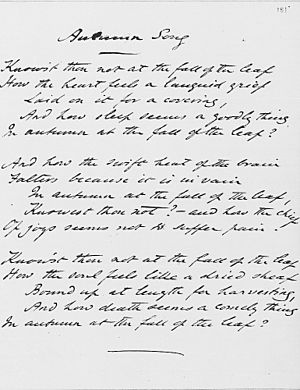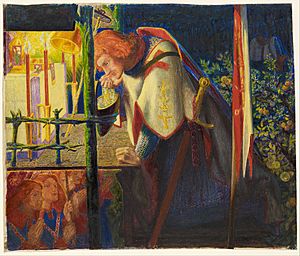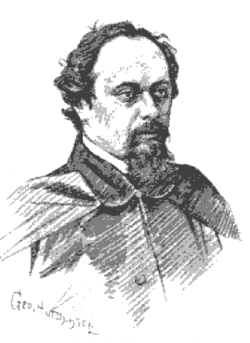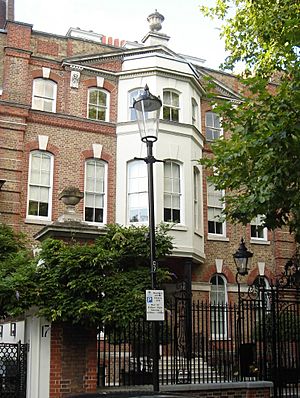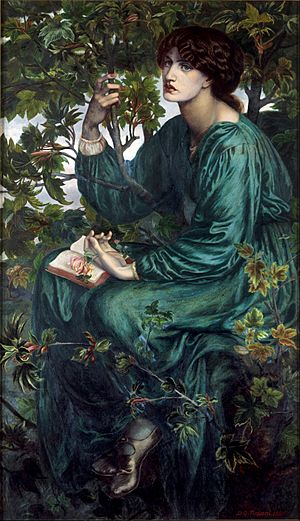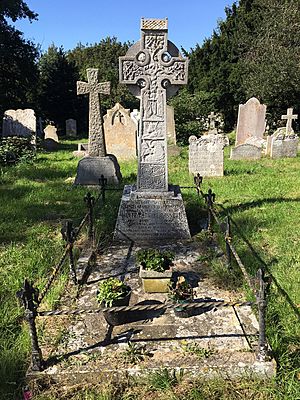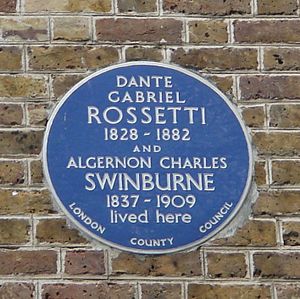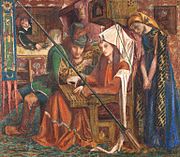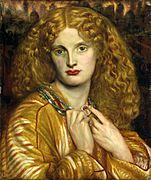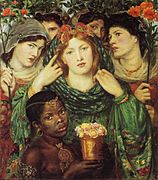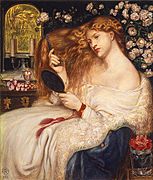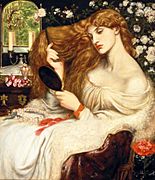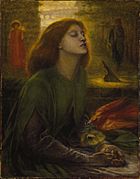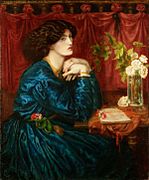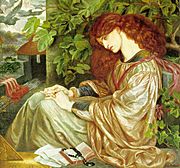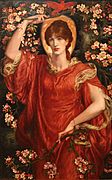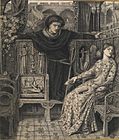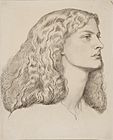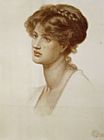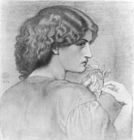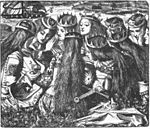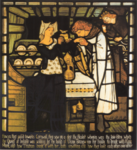Dante Gabriel Rossetti facts for kids
Quick facts for kids
Dante Gabriel Rossetti
|
|
|---|---|
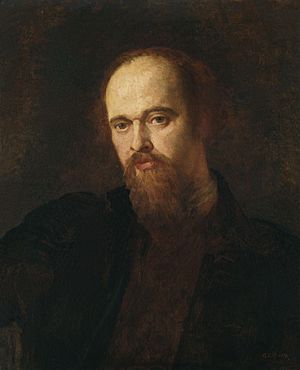
Portrait of Dante Gabriel Rossetti c. 1871, by George Frederic Watts
|
|
| Born | Gabriel Charles Dante Rossetti 12 May 1828 London, England |
| Died | 9 April 1882 (aged 53) Birchington-on-Sea, Kent, England |
| Occupation | Poet, illustrator, painter |
| Education |
|
| Spouse | |
| Signature | |
 |
|
Dante Gabriel Rossetti (born Gabriel Charles Dante Rossetti; May 12, 1828 – April 9, 1882) was a famous English poet, artist, and illustrator. He was a key member of the Rossetti family, known for their artistic talents. In 1848, he helped start the Pre-Raphaelite Brotherhood with his friends William Holman Hunt and John Everett Millais.
Rossetti's art often showed a love for medieval times and a rich, detailed style. His poems, especially The House of Life, explored deep thoughts and feelings. He often created art to go with his poems, and wrote poems to explain his paintings. For example, he illustrated Goblin Market by his talented sister, Christina Rossetti. His work inspired many artists and writers who came after him.
Contents
Early Life and Artistic Beginnings
Gabriel Charles Dante Rossetti was born in London on May 12, 1828. His father, Gabriele Pasquale Giuseppe Rossetti, was an Italian scholar. His mother was Frances Mary Lavinia Polidori. Friends and family called him Gabriel. But he put "Dante" first in his published works, honoring the famous Italian poet Dante Alighieri.
He grew up with his siblings, who were also very talented. His sister was the poet Christina Rossetti. His brother, William Michael Rossetti, became a critic. His other sister, Maria Francesca Rossetti, was an author. Gabriel was mostly taught at home. He loved reading the Bible and works by famous writers like Shakespeare and Dickens.
Rossetti was described as confident and passionate, even when he was young. He wanted to be a poet and a painter. He was especially interested in Medieval Italian art. He studied drawing from 1841 to 1845. Then he joined the Royal Academy but left in 1848. After that, he learned from Ford Madox Brown, who remained a close friend.
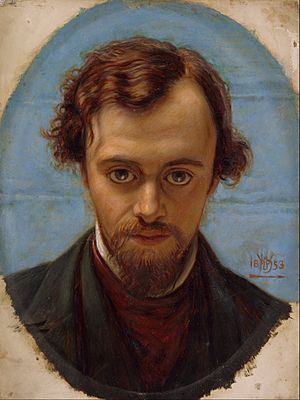
Rossetti became friends with William Holman Hunt after seeing his painting The Eve of St. Agnes. Rossetti felt Hunt shared his artistic ideas. Together, they formed the Pre-Raphaelite Brotherhood with John Everett Millais.
This group wanted to change English art. They felt art had become too mechanical after artists like Raphael. They wanted to go back to the detailed, colorful, and complex styles of early Italian and Flemish art. Rossetti was most interested in the medieval side of this movement. He translated poems by Dante and other medieval Italian poets.
Developing His Art Style
Rossetti's first big oil paintings showed the realistic style of the early Pre-Raphaelite movement. These included Girlhood of Mary Virgin (1849) and Ecce Ancilla Domini (1850). They showed Mary as a young girl.
After his second painting, Ecce Ancilla Domini, received criticism, Rossetti started using watercolours more. He could sell these paintings privately. Even though art critic John Ruskin supported his work, Rossetti rarely showed his art in public after this time.
Medieval Themes and Inspirations
In 1850, Rossetti met Elizabeth Siddal. She became an important model for the Pre-Raphaelite painters. She was his main inspiration and later his wife. They married in 1860. Rossetti's painting Found, started in 1853, was his only major painting about modern life. But he started to prefer symbolic and mythical images more and more.
For many years, Rossetti translated Italian poetry. This included Dante Alighieri's La Vita Nuova. These translations and stories from Sir Thomas Malory's Le Morte d'Arthur inspired his art in the 1850s. He developed a new way of painting with watercolours. He used thick colors mixed with gum to create rich effects, like medieval illuminated manuscripts.
His ideas about Arthurian legends and medieval designs also inspired William Morris and Edward Burne-Jones. They were greatly influenced by Rossetti's work. They met him when they asked him to contribute to their Oxford and Cambridge Magazine. Morris started this magazine in 1856 to share his ideas about art and poetry.
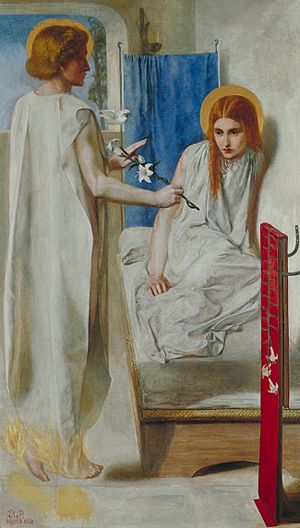
That summer, Morris and Rossetti visited Oxford. They saw the Oxford Union debating hall being built. They got a job to paint scenes from Le Morte d'Arthur on the walls. Seven artists worked on this project. The paintings faded quickly because they were done too fast. Rossetti found two sisters, Bessie and Jane Burden, to model for these murals. Jane later married William Morris in 1859.
Art in Books
Literature was always important to the Pre-Raphaelite Brotherhood's art. Many of their paintings directly referred to stories and poems. Rossetti was especially interested in making book designs and illustrations beautiful. He wanted them to fit with the ideas of the Aesthetic Movement.
He worked with his sister, Christina Rossetti, on the first editions of her books, Goblin Market (1862) and The Prince's Progress (1866).
One of Rossetti's most important contributions to book illustration was for Poems by Alfred, Lord Tennyson (published in 1857). Rossetti believed that illustrations should not just show what the poem says. He wanted them to be like separate artworks that added their own meaning. He wrote that he wanted to "allegorize on one’s own hook, without killing for oneself and everyone a distinct idea of the poet’s." This means his illustrations were deep and meaningful, not just simple pictures.
Religious Themes in His Work
In the mid-1800s, there was a renewed interest in religious traditions in England. This was called the Oxford Movement. Rossetti and his family attended churches that were part of this movement. These churches brought back some Catholic practices, like placing flowers and candles on the altar.
This religious revival greatly influenced Rossetti's art. For example, his painting The Girlhood of Mary Virgin (1849) shows an altar decorated like a Catholic one. The painting also shows the Virgin Mary sewing a red cloth. This was a practice emphasized by the Oxford Movement.
The Pre-Raphaelite Brotherhood aimed to show "moral reform" through their art. They wanted to be "truthful to nature." In Rossetti's story "Hand and Soul" (1849), his main character, Chiaro, is an artist with spiritual goals. Chiaro's spirit tells him to "set thine hand and thy soul to serve man with God." This shows Rossetti's blend of art, faith, and history.
His poem "The Blessed Damozel" (written between 1847 and 1870) uses religious language. It describes a woman looking down from "the gold bar of Heaven." This poem, like many of his works, connects the physical world with the spiritual.
A Change in Style
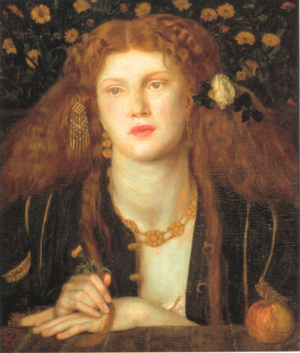
Around 1860, Rossetti started painting in oils again. He moved away from his detailed medieval scenes. Instead, he painted powerful, close-up images of women. These paintings often had flat backgrounds and rich colors. This new style greatly influenced the European Symbolist movement. His way of showing women became very distinct and artistic.
These new works were inspired by Italian Renaissance artists like Titian. In 1861, Rossetti helped start a decorative arts company called Morris, Marshall, Faulkner & Co.. He designed stained glass and other decorative items for the company.
Rossetti's wife, Elizabeth Siddal, passed away in 1862. This was a very sad time for him. He buried many of his unpublished poems with her. Later, he had them dug up. He often painted Elizabeth as Dante's Beatrice, a famous figure from Dante Alighieri's poetry. One example is his painting Beata Beatrix.
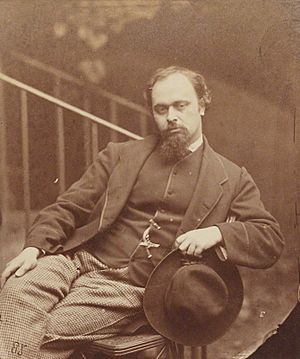
Life at Cheyne Walk
After his wife's death, Rossetti rented a large house at 16 Cheyne Walk in Chelsea, London. He lived there for 20 years. His home was filled with beautiful furniture and exotic animals. He loved wombats and even had them at his dinner table! He also owned a llama and a toucan.
During this time, he often painted Fanny Cornforth. She was a frequent model for him.
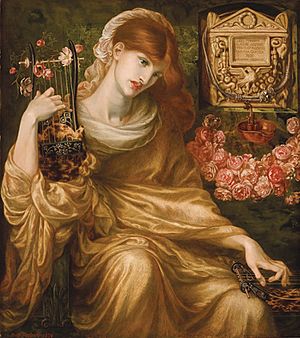
In 1865, he met Alexa Wilding, a dressmaker. He was struck by her beauty and hired her to model for him full-time. She posed for many of his famous works, including Veronica Veronese and The Blessed Damozel. She modeled for more of his finished paintings than anyone else. After Rossetti passed away, Alexa Wilding regularly placed a wreath on his grave.
Jane Morris, who had modeled for the Oxford Union murals, also posed for him during these years. She became a very important figure in his art and poetry. In 1869, Morris and Rossetti rented a country house, Kelmscott Manor, as a summer home.
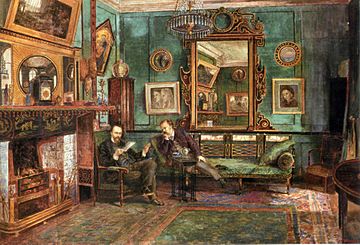
Friends encouraged Rossetti to dig up his poems from his wife's grave. He did this and published them in 1870 in a book called Poems by D. G. Rossetti. His most important literary work was The House of Life, a series of sonnets. He called a sonnet a "moment's monument." This meant it captured the feelings of a brief moment and explored their meaning. In 1881, he published another book of poems, Ballads and Sonnets.

Later Years and Passing
The harsh reviews of his first poetry book affected Rossetti deeply. He experienced a period of poor health in 1872. Although his health improved the next summer, he continued to struggle. He spent his last years mostly living alone at Cheyne Walk.
Dante Gabriel Rossetti passed away on April 9, 1882, at a friend's country house. He had been suffering from a kidney disease called Bright's Disease. He is buried in the churchyard of All Saints at Birchington-on-Sea, Kent, England.
Where to See His Work
Tate Britain in London, Birmingham, Manchester, and Salford all have large collections of Rossetti's art. The Salford Museum received many of his works after the artist L. S. Lowry passed away in 1976. Lowry was a big fan of Rossetti's work, especially his paintings of Lizzie Siddal and Jane Morris.
Lowry once said that Rossetti's women in his paintings were "not real women. [...] They are dreams." He believed Rossetti painted them this way after his wife's death. Rossetti's later paintings of women are very popular and often copied. They are known for their dreamy and intense beauty. His earlier works and drawings are less known, but they show his unique style and how he moved away from traditional art.
Rossetti in Media
Films and TV Shows
- Rossetti has been played by actors in several films and TV shows.
- Oliver Reed played him in the TV film Dante's Inferno (1967).
- Ben Kingsley played Rossetti in the BBC series The Love School (1975).
- Aidan Turner played him in the BBC show Desperate Romantics (2009).
- In an episode of Cheers, Dr. Frasier Crane (played by Kelsey Grammer) dresses as Dante Gabriel Rossetti for Halloween.
Books
- Dante Gabriel Rossetti and his family appear as characters in Tim Powers' novel "Hide Me Among the Graves."
His Influence on Others
- Rossetti's poem "The Blessed Damozel" inspired Claude Debussy's cantata La Damoiselle élue (1888).
- Composer John Ireland set Rossetti's poem "The One Hope" to music in 1926.
- In 1904, Ralph Vaughan Williams created a song cycle called The House of Life using six of Rossetti's poems. One of these songs, "Silent Noon," is very well-known.
- The 1990s band Hole used lines from Rossetti's poem "Superscription" in their song "Celebrity Skin."
Selected Works
Books by Rossetti
- The Early Italian Poets (a translation), 1861
- Poems, 1870
- Ballads and Sonnets, 1881
- The Collected Works of Dante Gabriel Rossetti, 1886 (published after his death)
Paintings by Rossetti
-
Beata Beatrix (1864–1870)
-
Jane Morris (The Blue Silk Dress) (1868)
Drawings by Rossetti
Woodcut Illustrations by Rossetti
-
King Arthur and the Weeping Queens, for Tennyson's Poems (1857)
Decorative Arts by Rossetti
Caricatures and Sketches by Rossetti
-
Death of a Wombat (1869)
See also
 In Spanish: Dante Gabriel Rossetti para niños
In Spanish: Dante Gabriel Rossetti para niños
- English art
- List of paintings by Dante Gabriel Rossetti
- Rossetti and His Circle, 1922 book by Max Beerbohm
- Rossetti–Polidori family tree
- James Smetham



